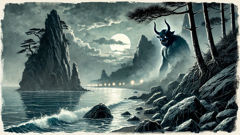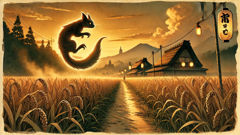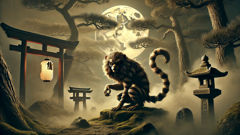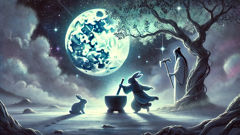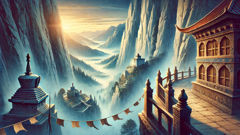Introduction
The coast of western Japan has always held a double life: by day it is a place of fishermen’s laughter, drying nets, and the silver flash of mackerel beneath a pale sun; by night it becomes a place of rumor, where the waves rearrange themselves into new shapes and the gaps between tide pools widen into mouths. It was in such a narrow cove—ringed by jagged rocks and the ribs of old pine—where the first stories of the Ushi-oni were told. Villagers spoke of a hulking shape seen only in the half-light between sunset and moonrise: an ox-headed demon, more than an animal, less than wholly ghost, with a hide like rotten bark and eyes like incoming storms. It moved along the waterline with an awkward, amphibious gait, sometimes swimming, sometimes lurching on four powerful legs, and sometimes rising up to stand like a grotesque sentinel on an outcrop to watch the fishermen stagger home. The Ushi-oni was feared because it preyed on the complacency of those who trusted the sea, but it was feared for a subtler reason too: it reflected the edges of human sorrow and anger. Where there was grief—an untimely death, a failed catch, a betrayal—the Ushi-oni seemed to gain shape. Over generations, its story braided itself into the rhythms of daily life, a way for people to name what they could not otherwise explain. This legend that follows is less an attempt to pin the creature down with dry facts than an exploration of how place and memory shape a yōkai, how a coastal community learns to live with a fear that is part weather, part memory, and how small acts—of ritual, cunning, and compassion—alter the meaning of a demon’s presence. As you read, imagine the salt smell, the hush after oars stop, the distant drum of surf, and the thin thread of lantern light bobbing among the rocks where fishermen once whispered about shadows with horns.
Origins, Sightings, and the Shape of Fear
The earliest tales of the Ushi-oni come wrapped in a geography as important as the creature itself. Western Japan’s coastline is a tapestry of coves and estuaries, places where river and sea negotiate boundaries and the weather can reverse itself in minutes. In such liminal spaces—where land and water argue over who may claim the tide—people have long felt that ordinary rules shift. The Ushi-oni emerges from this geography: it is literally and metaphorically a boundary creature. Oral accounts vary: some elders remember an ox-like head with curling horns and a maw full of teeth; others insist it is a monstrous shape whose face changes depending on who looks at it. Some fishermen insist the Ushi-oni wears seaweed like a cloak; others say it has barnacles embedded in its skin. Yet, across villages, common threads tie the reports together. The Ushi-oni prefers river mouths, inlets, and rock-strewn coves where undertows form unexpected currents. It appears most often at dusk and dawn, when light and shadow argue, and it is said to be particularly drawn to places marked by sorrow—sites of drownings, unresolved feuds, or abandoned shrines.
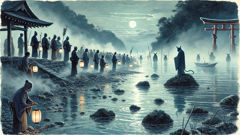
At the core of these tales is a human pattern: the need to name hazard and grief. In centuries when navigation was still a craft learned at a mother's knee and a father's stern hand, losing a netful of fish could mean hunger throughout the winter. When a boat capsized or a rope snapped, people asked, who sat on the cold of the water that night? A being like the Ushi-oni provided an explanation that made sense within the community’s worldview—a moral and natural hazard rolled into one. The ox, in Japanese symbolism, carries weight: sturdy, stubborn, yoked to human labor, and sometimes sacrificial. The Ushi-oni perverts these associations: it is strength turned predatory, endurance turned relentless. It steps from the farmyard into the tide, a creature out of place that punishes complacency and greed, but it also punishes those who forget the rituals that keep place and community health in balance. The Ushi-oni is therefore an instrument of social memory, a dark mirror reflecting the consequences when people fail to tend boundaries—both literal, like groynes and ropes, and symbolic, like respect for the dead and proper offerings at shrine-edge rocks.
Sightings accumulate in patterns, and with those patterns come adaptations. Villagers developed rituals to keep the Ushi-oni at bay. Offerings of sake poured at low tide, small torches placed on stakes to mimic the lanterns of boatmen, and chants performed at river mouths became standard response. The young were told not to go alone at dusk; the old taught songs that spoke the sea’s names and acknowledged debts to it. When the community failed to observe these rites—when a fisherman stole a good net, or when grudges were kept rather than resolved—the Ushi-oni’s visits intensified. Stories often describe a season: a relentless summer of fog, fish that fled the nets, and nights when the Ushi-oni’s cries—if cries they were—sounded from the headlands like a bell tolling at sea. How one explains that increased frequency depends on whether one sees the Ushi-oni as a supernatural being that feeds on sorrow or as a personified expression of ecological imbalance. The folk explanation, however, makes room for both. In some versions, a single grievous offense—an elder’s unatoned greed, a priest’s lapse in offering, an unburied corpse—can birth or re-invigorate the yokai. In others, the creature is older than memory, a primordial presence whose appetite waxes and wanes with the health of the shoreline.
As the story spread inland, it altered. Traders and travelers who visited the coast carried accounts back to mountain hamlets. There, the Ushi-oni became a story told at hearth-sides to explain the sound of distant oxen or to warn children away from rivers swollen by spring rains. The creature’s image also intersected with other yokai traditions: in some tales it bore the influence of oni—large, horned ogres of broad Japanese imagination—while in others it took on subtle, more ghostly attributes, a revenant of some wronged animal turned monstrous by human negligence. This blending is important because it shows how folklore lives: not as a fixed text but as a conversation across time and place. Each telling reshapes the Ushi-oni slightly, adapting it to local fears and local topographies. In coastal hamlets, details stay close to water: slippery rocks, sudden rips, the long, low breathing of the tide. In inland versions, the reef becomes a river bend and the cove becomes a slow pool behind a mill, but the moral outline—the danger of neglecting place and the way the past returns—remains.
The Ushi-oni also intersects with the human sense of guilt and reparation. Characters in the tales frequently stand at a crossroads: they can appease and restore balance or refuse and face the worsening fury of the sea. The stories that survive longest are those in which humans act—some out of bravery, some out of cunning, some prompted by a deeper sacrificial love. There is a recurrent motif of the emissary: often a fisherman's daughter or an itinerant priest who, through song, trickery, or an offering of great personal cost, manages to placate the beast or drive it off the rocks. These episodes are rarely triumphalist. The Ushi-oni's defeat, when it happens, is messy and costly, and it usually leaves behind a lesson about humility, community, and the ongoing requirement of ritual. Even when the creature is driven away, its memory remains as a warning that the sea is a living ledger that remembers debts owed, and that stories—told and retold—are among the only tools humans have to keep those debts from festering into monsters.
Confronting the Ox Demon: Rituals, Cunning, and the Human Heart
The Ushi-oni stories that became most beloved—and most repeated—are those that focus on confrontation. Confrontation narratives do not always mean physical combat; often they are stories of ritual, negotiation, and moral reckoning. In the coastal villages, community responses varied with history and resources. Some hamlets relied on the discipline of ritual: priests from small shrines would lead processions at the seasons when the Ushi-oni was rumored to be strongest. They waved tamagushi and chanted sutras, went down to the tide line at dawn to pour libations, and nailed talismans to stakes in the sand. These acts were partly spiritual and partly pragmatic: a village that honored its shoreline with ceremonies was less likely to face the communal consequences of neglect, because ritual enforces attention. Where an old custom fell away—perhaps because a temple had lost its priest or because younger people left for the city—the stories say, the Ushi-oni returned. Ritual failure therefore functions in the legends as a proxy for social breakdown.
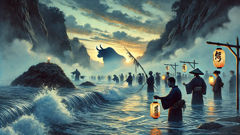
Other confrontations were cleverer than they were pious. There are numerous accounts of fishermen using trickery to outwit the ox demon. One story tells of an old boat captain whose son had been taken by the Ushi-oni after a fierce storm. The captain refused to cower. He observed the creature for nights, mapping its patterns like a hunter. He noticed its attraction to bright, reflective objects and its peculiar fear—if one could call it fear—of the sound of a sharp bell coupled with the scent of roasted kelp. On a moonless night, the captain fastened mirrors to oars and hung baked kelp from a pole, ringing a small bronze bell as he rowed toward the headland where the Ushi-oni liked to lie. When the monster rose, drawn to the glint and the smell, the captain used the light to dazzle it and the bell to unsettle it, and then he lured it toward a narrow throat of water where the tide runs fastest. There, with the help of other boats cutting off escape routes, the Ushi-oni was trapped long enough for the villagers to perform a rite of binding, after which the creature slid away into deeper water. Such stories emphasize cunning and community action rather than solitary heroism. They are also practical: in a landscape where the sea is unpredictable, attention to pattern and cooperation are survival skills.
Then there are stories that drift toward tragedy, where the line between monster and victim blurs. One version tells of a young woman named Asa who lived in a village that had been losing fish and men to the sea. After her brother drowned, villagers whispered that the Ushi-oni had been more active than ever. Asa, who had always been quick with her hands, made small wooden figures—tiny oxen carved from driftwood—and placed them at the edges of the cove along with rice, sake, and the scent of incense. She did this every night, quietly, knowing that her actions were small and insufficient. The community mocked her at first; then, one dawn, they found her sleeping on the rocks, parchment talismans on her breast, and a track of deep, wet hoofprints leading away into the surf. No one could say whether her offerings appeased the Ushi-oni or whether the creature had simply chosen a new ground for its hunger, but fishermen noticed that after Asa's ritual the sea eased somewhat, and the nets came up with a little more silver. Asa's act becomes in the telling a parable about mourning and modest devotion. It suggests that sometimes what keeps the monstrous at bay is not spectacle but the steady repetition of small, respectful acts.
Importantly, the stories also include those who refused to submit to fear, and whose defiance took a form both practical and humane. Priests, traveling exorcists, and itinerant storytellers played a role in reframing the Ushi-oni as a being bound by laws—human and cosmic. They argued that most yokai are not pure evil but expressions of imbalance. Repairing that imbalance could require sacrifice—sometimes a meal offered at the waterline, sometimes the restoration of a neglected grave or shrine. The narrative arc in many of these tales moves from fear to recognition: once people admit the causes of the Ushi-oni's visits, they can act with a mixture of reverence and strategy. There are also accounts where a merciful act, rather than a violent one, changes the story. In one coastal legend, a child throws his last rice cake into a tide pool for a small, tormented presence that turns out to be the humanized core of the Ushi-oni: a woman who long ago drowned and whose sorrow had been feeding into the monster. The child’s kindness is not a cartoon cure but an entry into a more complex truth: that at the heart of many yokai tales lies a fractured humanity.
These variations reveal the Ushi-oni's role as a moral and ecological actor in folklore. The monster is not merely a scare tactic; it is an instrument of collective memory and social regulation. Stories insist that when people observe boundaries—ritual, practical, and moral—the Ushi-oni’s hunger diminishes. When they ignore those boundaries, it grows. This folklore has modern resonance: in contemporary times, when development pushes into coastlines and pollution changes fish migrations, a tale like the Ushi-oni can be read as a cultural way of noticing environmental disturbance. It remains important to stress, though, that the legend operates on more than a single level. It is simultaneously an ecological parable, an exploration of communal guilt, and a narrative practice through which communities articulate their anxieties about change. In the end, whether the Ushi-oni is read as a true supernatural predator, as a metaphor for environmental imbalance, or as a narrative device for social cohesion, the stories insist on a shared truth: people living by the sea must listen to the sea, honor its thresholds, and tend the old rituals that make place livable.
Across centuries, the Ushi-oni continued to shadow the water's edge of western Japan—sometimes less visible, at other times returning with a vengeance. But it never quite left the popular imagination. It appears now in festivals where men and women dress as horned beasts to perform remembrance, in woodblock prints that capture a monstrous silhouette against a storm, and in modern retellings that examine the creature through new lenses—gender, environmentalism, and psychological trauma. These modern versions are not betrayals; they are the next stage in a living tradition, proof that a good story endures because it can bend without breaking. The Ushi-oni remains a powerful symbol: a creature born where elements meet, an admonition against neglect, and a reminder that humans and place are entangled in ways that demand attention, ritual, and sometimes, the courage to reach into the water at dawn and whisper apologies to the tide.
Conclusion
The Ushi-oni endures because it is less a single monster and more a story of thresholds: between sea and land, between care and neglect, between the living and the unresolved dead. Its image—an ox-headed demon with a taste for the shore—serves as an emblem of what might happen when communities forget to tend to both their rituals and their responsibilities. Yet the legends also insist on solutions that are modest and communal: offerings at the tide line, agreements made and kept, the return of songs that name the sea’s moods. Modern readers can take more than spooky pleasure from the tale. The Ushi-oni is a caution about ecological balance and social memory, a reminder that stories carry practical knowledge about how to live well in a particular landscape. In times of change—when young people migrate to cities, when storms come fiercer, when rivers run differently because of human choices—the story of the Ushi-oni presses on the imagination and asks a question every generation must answer: what will you do to keep the boundary between human need and natural consequence from snapping? The answer, the old tales suggest, is never a simple triumph. It is steady work: making offerings, repairing shrines, listening for the water’s small, precise complaints, and teaching the next child to respect the tide. In that work, the demon’s howl grows quieter, and the sea, for a time, seems willing to forgive.

